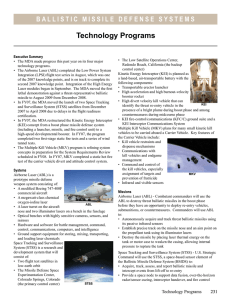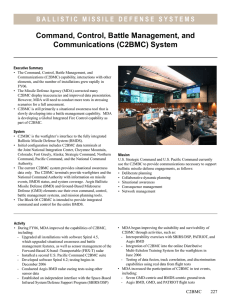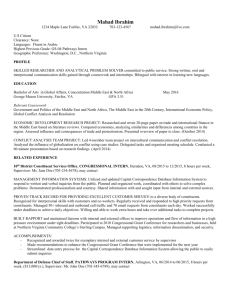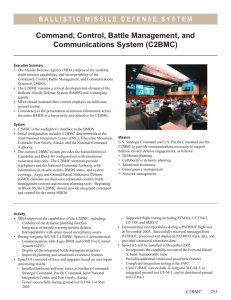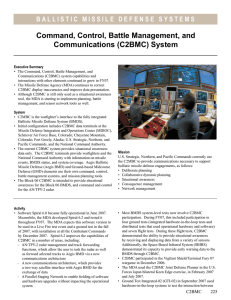Technology Programs
advertisement
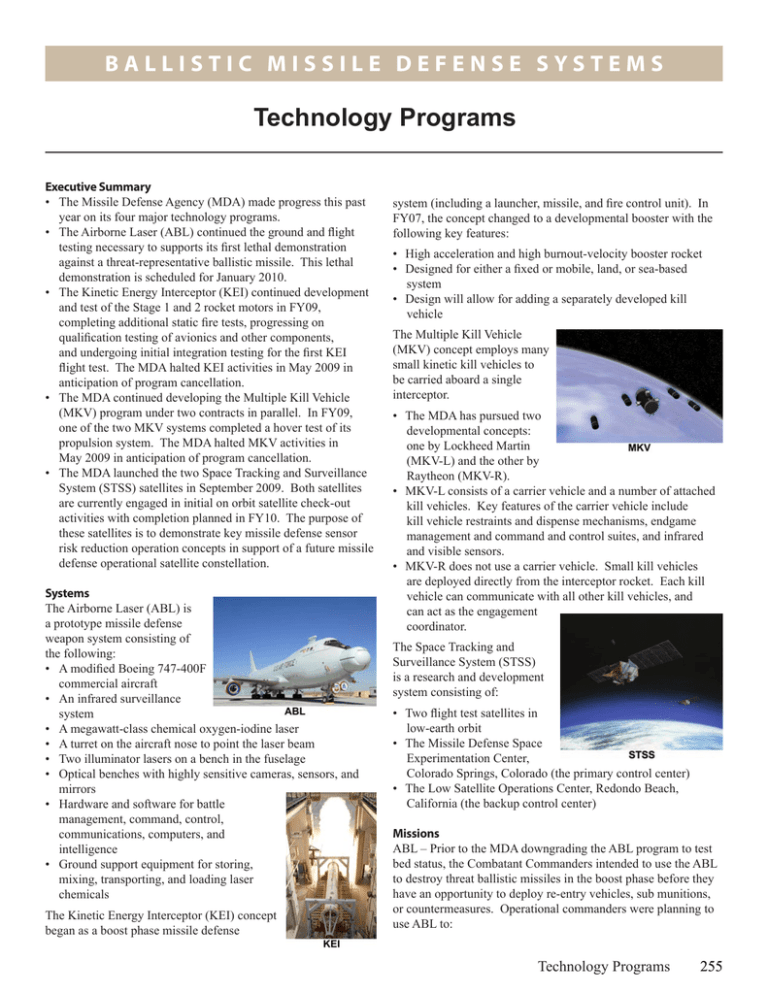
BALLIS T I C M ISSILE D EFENSE SYS T E M s Technology Programs Executive Summary • The Missile Defense Agency (MDA) made progress this past year on its four major technology programs. • The Airborne Laser (ABL) continued the ground and flight testing necessary to supports its first lethal demonstration against a threat-representative ballistic missile. This lethal demonstration is scheduled for January 2010. • The Kinetic Energy Interceptor (KEI) continued development and test of the Stage 1 and 2 rocket motors in FY09, completing additional static fire tests, progressing on qualification testing of avionics and other components, and undergoing initial integration testing for the first KEI flight test. The MDA halted KEI activities in May 2009 in anticipation of program cancellation. • The MDA continued developing the Multiple Kill Vehicle (MKV) program under two contracts in parallel. In FY09, one of the two MKV systems completed a hover test of its propulsion system. The MDA halted MKV activities in May 2009 in anticipation of program cancellation. • The MDA launched the two Space Tracking and Surveillance System (STSS) satellites in September 2009. Both satellites are currently engaged in initial on orbit satellite check-out activities with completion planned in FY10. The purpose of these satellites is to demonstrate key missile defense sensor risk reduction operation concepts in support of a future missile defense operational satellite constellation. Systems The Airborne Laser (ABL) is a prototype missile defense weapon system consisting of the following: • A modified Boeing 747-400F commercial aircraft • An infrared surveillance system • A megawatt-class chemical oxygen-iodine laser • A turret on the aircraft nose to point the laser beam • Two illuminator lasers on a bench in the fuselage • Optical benches with highly sensitive cameras, sensors, and mirrors • Hardware and software for battle management, command, control, communications, computers, and intelligence • Ground support equipment for storing, mixing, transporting, and loading laser chemicals The Kinetic Energy Interceptor (KEI) concept began as a boost phase missile defense system (including a launcher, missile, and fire control unit). In FY07, the concept changed to a developmental booster with the following key features: • High acceleration and high burnout-velocity booster rocket • Designed for either a fixed or mobile, land, or sea-based system • Design will allow for adding a separately developed kill vehicle The Multiple Kill Vehicle (MKV) concept employs many small kinetic kill vehicles to be carried aboard a single interceptor. • The MDA has pursued two developmental concepts: one by Lockheed Martin (MKV-L) and the other by Raytheon (MKV-R). • MKV-L consists of a carrier vehicle and a number of attached kill vehicles. Key features of the carrier vehicle include kill vehicle restraints and dispense mechanisms, endgame management and command and control suites, and infrared and visible sensors. • MKV-R does not use a carrier vehicle. Small kill vehicles are deployed directly from the interceptor rocket. Each kill vehicle can communicate with all other kill vehicles, and can act as the engagement coordinator. The Space Tracking and Surveillance System (STSS) is a research and development system consisting of: • Two flight test satellites in low-earth orbit • The Missile Defense Space Experimentation Center, Colorado Springs, Colorado (the primary control center) • The Low Satellite Operations Center, Redondo Beach, California (the backup control center) Missions ABL – Prior to the MDA downgrading the ABL program to test bed status, the Combatant Commanders intended to use the ABL to destroy threat ballistic missiles in the boost phase before they have an opportunity to deploy re-entry vehicles, sub munitions, or countermeasures. Operational commanders were planning to use ABL to: Technology Programs 255 BALLIS T I C M ISSILE D EFENSE SYS T E M S • Autonomously acquire and track threat ballistic missiles using its passive infrared sensors • Establish precise track on the missile nose and an aim point on the propellant tank or motor case using its illuminator lasers • Destroy the missile by placing laser thermal energy on the tank or motor case to weaken the casing, allowing internal pressure to rupture the tank • Generate and pass target cues to the Ballistic Missile Defense Systems (BMDS) and theater assets. KEI – Prior to cancellation, the MDA intended to use the KEI booster as part of a primary intercept missile in the BMDS to: • Intercept threats in boost, ascent, and midcourse phases of flight • Intercept medium-, intermediate-, and long-range ballistic missiles • Boost alternate kill vehicles toward the interception point MKV – Prior to cancellation, the MDA intended to use the MKV as the primary kill mechanism for the Ground-Based Interceptor Knowledge Point Progress For the technology and other programs, the MDA uses knowledge points to measure development progress by focusing on the set of critical activities that define each program’s risk. The MDA defines a technology Knowledge Point as a development event that provides critical information for a key technology decision. This approach allows the MDA to make informed decisions on advancement of a development activity. Airborne Laser • Knowledge Point #6: Conduct First Light into the Laser Calorimeter on the aircraft during ground tests. The MDA completed this knowledge point in FY08. • Knowledge Point #7: Conduct First Light through the Beam Control/Fire Control Subsystem during aircraft ground tests. The MDA completed this knowledge point in FY09. • Knowledge Point #8: Engagement with a low-power boosted diagnostic target. The MDA completed this knowledge point in FY09. • Knowledge Point #9: Demonstrate High-Energy Laser performance in flight. The MDA plans to complete this Knowledge Point in early FY10. • Knowledge Point #10: Engagement with a high power boosted diagnostic target. The MDA plans to complete this Knowledge Point in early FY10. • Knowledge Point #11: ABL lethal demonstration to negate a threat-representative ballistic missile during the boost phase. The MDA made substantial progress towards the lethality demonstration with multiple in-flight tracking events using airborne diagnostic and missile targets. However, the lethal demonstration has been delayed to January 2010. Kinetic Energy Interceptor • Knowledge Point #2: Demonstrate High Acceleration Booster. KEI testing in FY09 supported progress toward Knowledge 256 Technology Programs and KEI-booster interceptor deployed in the BMDS, to mitigate the target discrimination problem by destroying all major objects in the field of view using many small kill vehicles. STSS – U.S. Strategic Command will use the STSS, a space‑based sensor element of the BMDS to: • Acquire, track, assess, and report ballistic missile and intercept events from lift-off to re-entry • Provide a space node to support data fusion, over-the-horizon radar/sensor cueing, intercept data handover to other BMDS sensors and interceptors, and fire control Prime Contractors • ABL: The Boeing Company, Integrated Defense Systems, Missile Defense Systems, Huntsville, Alabama • KEI: Northrop Grumman, Huntsville, Alabama • MKV: Raytheon Missile Systems, Tucson, Arizona; and Lockheed Martin Corporation, Sunnyvale, California • STSS: Northrop Grumman, Redondo Beach, California Point #2. The MDA originally scheduled this knowledge point for completion after a booster verification flight test in fall 2009, but the MDA removed the flight test from the schedule in May 2009, in anticipation of program cancellation. - The MDA conducted Stage 1 and 2 static fire testing in October and November 2008. - Qualification testing of booster avionics and structures continued through early FY09. - The MDA delivered a preliminary version of the missile consisting of inert stages to Vandenberg AFB, California. The MDA used the inert missile in preparation activities for the first flight test. Multiple Kill Vehicle • In December 2008, MKV-L completed a hover test, during which the MKV-L’s propulsion system demonstrated maneuverability while tracking a simulated target. • MKV Knowledge Point #1a: Kill Vehicle Selection for SM-3 Block IIA with Japan. The MDA conducted system and payload trade studies and a joint system concept review to complete the knowledge point. • MKV Knowledge Point #1b: Define Commonality Characteristics for all Kill Vehicles. Prior to program cancellation, the MDA had scheduled the knowledge point for completion by FY09. • MKV Knowledge Point #1c through 4b: Prior to program cancellation, the MDA had scheduled these knowledge points for completion between FY10 and FY15. Space Tracking and Surveillance System • Knowledge Point #2: Space Vehicle Integration. This knowledge point was completed with the launch of the two STSS satellites in September 2009. BALLIS T I C M ISSILE D EFENSE SYS T E M s • Knowledge Point #3: Confirm Constellation Performance Affordability. The MDA had planned to complete this knowledge point by FY08, but, with the launch delays, the completion date has slipped to FY10. • Transition Knowledge Point: With the two STSS satellites now on orbit, the MDA will conduct two major flight tests to characterize sensor performance. The flight tests will serve as a risk reduction for the eventual fielding of an operational constellation of satellites. The first flight test, Flight Test STSS (FTS)-01, scheduled for 3QFY10, will test the ability of STSS to detect, acquire, and track a theater threat. FTS-02 will test the ability of STSS to detect, acquire, and track a strategic ballistic missile. Recommendations • Status of Previous Recommendations. There were no previous recommendations. • FY09 Recommendations. None. Technology Programs 257 BALLIS T I C M ISSILE D EFENSE SYS T E M S 258

